Lessons from abroad: If Republicans controlled U.S. education policy? Australia offers a sneak peek
What would happen if conservative ideas for improving education were given free reign in the United States? If Republicans take over the Senate and then the White House, a possibility, Americans might find out in the near future.
Australia, similar in many ways to the U.S., provides a glimpse of what a transfer of power might mean for schools.

Photo: Marco Antonio Torres
In 2013, Australia’s conservative party won control of Parliament, ousting a progressive Labor Party majority. The significant left-to-right swing has left many parts of the nation in flux, including the education sector. Like the U.S., Australia has significant urban and rural student populations and struggles with balancing state and federal authority.
Both countries have a significant portion of children living in poverty – roughly 17 percent in Australia and about 22 percent in America. And Australians, too, are concerned with how they rank on international assessments.
Their main strategies for fixing schools, such as providing more choice to students and addressing standards, are also similar to ours. As the new conservative government launches its education policy, it could offer clues to how their strategies might play out here.
I spent the past week in Australia and nearly every educator that I talked to mentioned how many uncertainties the country’s schools are facing right now – and were generally pessimistic about the new government. The current unknowns also show just how difficult it can be to install lasting changes in an education system when the balance of power keeps shifting. Here’s some of what’s at stake:
• School funding. In both K-12 schools and at universities, educators are anxiously awaiting a final budget from the new government. The previous government pledged more than $944 million between 2013 and 2017 to the Higher Education Participation and Partnerships Program. All of the country’s universities were charged with designing programs to attract and support disadvantaged students in exchange for the funding. Now, no one knows if they’ll have the federal money to continue these programs. If not, institutions may have to scale back or scrap them all together.
At the primary and secondary level, the government originally planned to create its own funding formula, but committed to the liberal Labor Party’s previous funding levels for at least the next four
